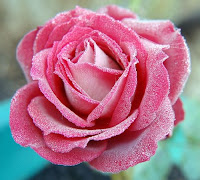From Bleu 2 to Bleu 3
On August 31st, I finished the score of Bleu 3, a composition for clarinet, violin, cello, and piano.

Today, I wrote program notes:
I composed Bleu 3 during the summer 2007. The piece has been inspired by the triptych "Les trois bleu" by Juan Miró. For this project, I adopted an iterative composition process involving several interests of mine.
First, I recorded Bleu 1, a series of three miniatures improvised on bass clarinet, basset-horn, and contrabass clarinet, using each of the three paintings as instantaneous inspiration.
The next step has been an electronic music piece called Bleu 2. All the sounds in this piece result from transformations of the Bleu 1 sound file through personal spectral processing tools.
Finally, Bleu 3 is a transcription of Bleu 2 into a quartet for clarinet, violin, cello, and piano. The eight sections of the piece are called Cristal, Fouillis, Louange, Ange, Abîme, Danse, Arcs-en-ciel, and Fureur.
Bleu 3 is an homage to Olivier Messiaen and is dedicated to Bénédicte.
Transcription
This post is about the transcription of Bleu 2. Why not listen to it while reading on?
"Composing is choosing." says my former professor Ivan Fedele. While translating the music from electronic sounds to acoustic instruments, I made many choices. For instance, the 5 harmonies used in the Danse section come from the electronic music of Bleu 2, from 6'20" to 6'50". Two of my choices have been: first, which pitches I used among the quantity of partials present in the electronic sounds; second, to not use microtones but rather to write only tempered notes (in fact, I used one microtone in the clarinet part, bar 29, to generate beatings with the violin almost at unison.) I analysed the sounds not only with my ears, but also with a piano and a really simple program, home-made in the Max/MSP environment. Here are the 5 harmonic fields I finally used in the Danse section:

Abîme
As you may have noticed, I named sections with words from Olivier Messiaen's Quatuor pour la fin du temps section titles. I wanted to have an abîme, in homage to Messiaen's Abîme des Oiseaux for solo clarinet. But being a clarinetist, I "had to" avoid the clarinet. Finally, my Abîme is a "solo" played by violin and cello, two instruments instead of one, to render thicker lines. Moreover, the "solo" evolves over a silence colored by the piano playing a soft ostinato. As for the harmonies, the pitches come from the Abîme section of Bleu 2.
Here is an excerpt (corresponds to the sound file above between 5'48" and 6'00") of Abîme, in manuscript and final version. Click to enlarge:

Noise
Electronic music relies a lot on the tension between harmonic, inharmonic, and noisy sounds. Similarly, this acoustic piece presents different qualities of sound, from purely harmonic to distorded pitches to (almost-)white noise.
To achieve this richness of timbres, I made extensive use of extended technique in all four instruments. It has been the occasion for me to study more music by Henry Cowell and George Crumb, especially because it is the first time I compose a precise written score for the piano.
For instance, in the Ange section, the pianist presses firmly a glass tumbler or a mug against the strings inside the piano, while playing with one hand on the keys. This technique is used by George Crumb in his piece for solo piano Makrokosmos.

A more common way of distorting traditional piano playing is to play clusters. In the Fureur section, the right hand plays clusters, while the left hand maintains a kind of Keith Jarrett-inspired groove:




Comments
Post a Comment